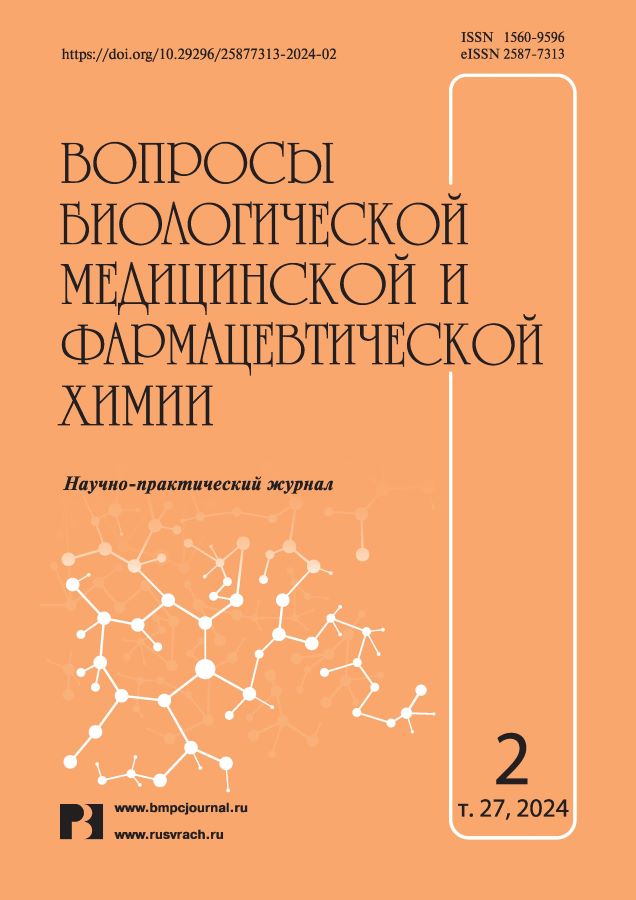Comparative analysis of chemical composition of Thymus serpyllum L. and Thymus marschallianus Willd. essential oils by gas-liquid chromatography with mass spectrometry detection. Problems of biological, medical and pharmaceutical chemistry
- 作者: Sheremetyeva A.S.1, Karavaeva L.V.1, Durnova N.A.1, Shapoval O.G.1, Mukhamadiev N.Q.2, Rabbimova G.T.2, Nazirbekov M.H.3
-
隶属关系:
- Saratov State Medical University, named after V.I. Razumovsky
- Samarkand State University, named after Sh. Rashidov
- Scientific Center for Quality Control and Turnover of Veterinary Medicines, feed Additives
- 期: 卷 27, 编号 2 (2024)
- 页面: 48-56
- 栏目: Pharmaceutical chemistry
- URL: https://journals.eco-vector.com/1560-9596/article/view/627117
- DOI: https://doi.org/10.29296/25877313-2024-02-06
- ID: 627117
如何引用文章
详细
Introduction. Plant essential oils are natural sources of the different compounds, the action of which in the macroorganism is determined by their chemical composition, depending on environmental factors, including plant species.
Aim. The aim of the study was to compare the chemical composition of essential oils, obtained from the aerial parts of Thymus serpyllum L. and Thymus marschallianus Willd. (Lamiaceae).
Material and methods. The plant raw materials of Thymus marschallianus were collected in the flowering phase in the Saratov region in June, the plant raw materials of Thymus serpyllum were purchased in the pharmacy network. The essential oils were obtained by Ginsberg’s steam hydrodistillation method. Analysis of their chemical composition was performed by gas-liquid chromatography with mass spectrometry detection.
Results. The main components of both types of the essential oils were represented by thymol and its isomers, their mass fraction in the essential oil of T. marschallianus is 38.4, in the essential oil of T. serpyllum is 44%. The comparative analysis was carried out using the non-parametric Mann-Whitney criterion. Statistically significant differences with 95% probability were established for tricyclic sesquiterpene alkenes, the total content of which in the essential oil of T. marschallianus is 4.73%, in the essential oil of T. serpyllum – 3.59%.
Conclusion. According to their chemical composition the essential oils of the mentioned plant species belong to phenolic chemotype and are similar in the major compounds.
全文:
作者简介
A. Sheremetyeva
Saratov State Medical University, named after V.I. Razumovsky
Email: anna-sheremetyewa@yandex.ru
Senior Teacher, Department of General Biology, Pharmacognosy and Botany
俄罗斯联邦, SaratovL. Karavaeva
Saratov State Medical University, named after V.I. Razumovsky
Email: anhelokar@gmail.com
Assistant, Department of General Biology, Pharmacognosy and Botany
俄罗斯联邦, SaratovN. Durnova
Saratov State Medical University, named after V.I. Razumovsky
Email: ndurnova@mail.ru
Dr.Sc. (Biol.), Associate Professor, Head of Department of General Biology, Pharmacognosy and Botany
俄罗斯联邦, SaratovO. Shapoval
Saratov State Medical University, named after V.I. Razumovsky
Email: ogshapoval@gmail.com
Ph.D. (Med.), Associate Professor, Department of Microbiology, Virology and Immunology
俄罗斯联邦, SaratovN. Mukhamadiev
Samarkand State University, named after Sh. Rashidov
编辑信件的主要联系方式.
Email: m_nurali@mail.ru
Dr.Sc. (Chem.), Professor, Department of Physical and Colloidal Chemistry
乌兹别克斯坦, Samarkand
G. Rabbimova
Samarkand State University, named after Sh. Rashidov
Email: gulnora_1968_r@mail.ru
Ph.D. (Med.), Associate Professor, Department of Obstetrics and Gynecology № 2
乌兹别克斯坦, SamarkandM. Nazirbekov
Scientific Center for Quality Control and Turnover of Veterinary Medicines, feed Additives
Email: mobeck@mail.ru
Analytical Chemist
乌兹别克斯坦, Tashkent参考
- Diniz do Nascimento L., Moraes A.A.B., Costa K.S.D. et al. Bioactive natural compounds and antioxidant activity of essential oils from spice plants: new findings and potential applications. Biomolecules. 2020; 10(7): 988. doi: 10.3390/bi-om10070988.
- Nieto G.A. Review on applications and uses of thymus in the food industry. Plants. 2020; 9(8): 961. doi: 10.3390/plants 9080961.
- Truzzi E., Durante C., Bertelli D., et al. Rapid classification and recognition method of the species and сhemotypes of essential oils by ATR-FTIR spectroscopy coupled with che-mometrics. Molecules. 2022; 27(17): 5618. DOI: 0.3390/mo-lecules27175618.
- Vaiciulyte V., Loziene K., Taraskevicius R. Impact of edaphic and climatic factors on Thymus pulegioides essential oil composition and potential prevalence of chemotypes. Plants. 2022; 11(19): 2536. DOI: 10.3390/ plants11192536.
- Ebrahimi S. Nejad, Hadian J., Mirjalili M.H., et al. Essential oil composition and antibacterial activity of Thymus caramanicus at different phenological stages. Food Chem. 2008; 110(4): 927–931. doi: 10.1016/j.foodchem.2008.02.083.
- Sheremet'eva A.S., Durnova N.A., Berezuckij M.A. Soderzhanie jefirnyh masel v trave raznyh vidov roda tim'jan (Thymus L.). Bjulleten' Botanicheskogo sada Saratovskogo gosudarstvennogo universiteta. 2017; 15(2): 15–19. doi: 10.18500/1682-1637-2017-15-2-15-19.
- Milenkovic L., Ilic Z.S., Sunic L., et al. Modification of light intensity influence essential oils content, composition and antioxidant activity of thyme, marjoram and oregano. Saudi J. Biological. Sci. 2021; 28(11): 6532–43. doi: 10.1016/j.sjbs. 2021.07.018.
- Hammoudi Halat D., Krayem, M., Khaled S., et al. Focused insight into Thyme: biological, chemical and therapeutic properties of an indigenous Mediterranean herb. Nutrients. 2022; 14(10): 2104. doi: 10.3390/nu14102104.
- Vinokurova O.A., Trineeva O.V., Slivkin A.I. Sravnitel'naja harakteristika razlichnyh vidov tim'jana: sostav, svojstva, primenenie (obzor). Razrabotka i registracija lekarstvennyh sredstv. 2016; 4: 134–50.
- Fedorov A.A. Flora evropejskoj chasti SSSR: T. 3. L.: Nauka, 1978; 259 с.
- Sidiropoulou E., Marugan-Hernandez V., Skoufos I. et al. In vitro antioxidant, antimicrobial, anticoccidial, and anti-inflammatory study of essential oils of oregano, thyme, and sage from Epirus, Greece. Life (Basel). 2022; 12(11): 1783. doi: 10.3390/life12111783.
- Aljabeili H.S., Barakat H., Abdel-Rahman H.A. Chemical composition, antibacterial and antioxidant activities of Thyme essential oil (Thymus vulgaris). Food Nutr. Sci. 2018; 9: 433–46. doi: 10.4236/fns.2018.95034.
- Durnova N.A., Romanteeva A.N., Kovtun A.N. Himicheskij sostav jefirnogo masla tim'jana Marshalla i tim'jana Pallasa, proizrastajushhih na territorii Saratovskoj oblasti. Himija rastitel'nogo syr'ja. 2014; 2: 115–19. doi: 10.14258/jcprm.1402115.
- Imelouane B., Amhamdi H., Wathelet J.P. et al. Chemical composition and antimicrobial activity of essential oil of thyme (Thymus vulgaris) from Eastern Morocco. Int. J. Agric. Biol. 2009; 11(2): 205–208.
补充文件





